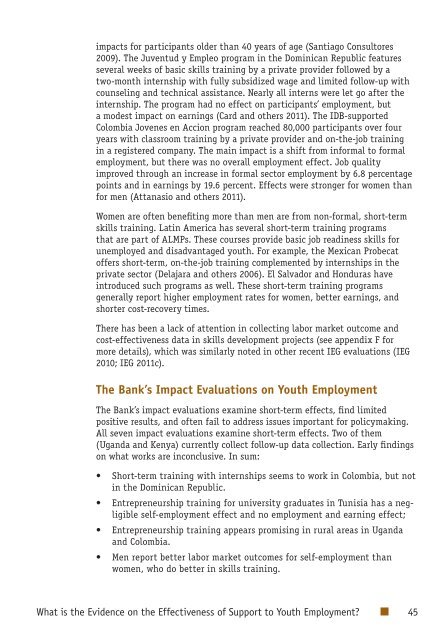Youth Employment Programs - Independent Evaluation Group
Youth Employment Programs - Independent Evaluation Group
Youth Employment Programs - Independent Evaluation Group
Create successful ePaper yourself
Turn your PDF publications into a flip-book with our unique Google optimized e-Paper software.
impacts for participants older than 40 years of age (Santiago Consultores2009). The Juventud y Empleo program in the Dominican Republic featuresseveral weeks of basic skills training by a private provider followed by atwo-month internship with fully subsidized wage and limited follow-up withcounseling and technical assistance. Nearly all interns were let go after theinternship. The program had no effect on participants’ employment, buta modest impact on earnings (Card and others 2011). The IDB-supportedColombia Jovenes en Accion program reached 80,000 participants over fouryears with classroom training by a private provider and on-the-job trainingin a registered company. The main impact is a shift from informal to formalemployment, but there was no overall employment effect. Job qualityimproved through an increase in formal sector employment by 6.8 percentagepoints and in earnings by 19.6 percent. Effects were stronger for women thanfor men (Attanasio and others 2011).Women are often benefiting more than men are from non-formal, short-termskills training. Latin America has several short-term training programsthat are part of ALMPs. These courses provide basic job readiness skills forunemployed and disadvantaged youth. For example, the Mexican Probecatoffers short-term, on-the-job training complemented by internships in theprivate sector (Delajara and others 2006). El Salvador and Honduras haveintroduced such programs as well. These short-term training programsgenerally report higher employment rates for women, better earnings, andshorter cost-recovery times.There has been a lack of attention in collecting labor market outcome andcost-effectiveness data in skills development projects (see appendix F formore details), which was similarly noted in other recent IEG evaluations (IEG2010; IEG 2011c).The Bank’s Impact <strong>Evaluation</strong>s on <strong>Youth</strong> <strong>Employment</strong>The Bank’s impact evaluations examine short-term effects, find limitedpositive results, and often fail to address issues important for policymaking.All seven impact evaluations examine short-term effects. Two of them(Uganda and Kenya) currently collect follow-up data collection. Early findingson what works are inconclusive. In sum:• Short-term training with internships seems to work in Colombia, but notin the Dominican Republic.• Entrepreneurship training for university graduates in Tunisia has a negligibleself-employment effect and no employment and earning effect;• Entrepreneurship training appears promising in rural areas in Ugandaand Colombia.• Men report better labor market outcomes for self-employment thanwomen, who do better in skills training.What is the Evidence on the Effectiveness of Support to <strong>Youth</strong> <strong>Employment</strong>? 45
















